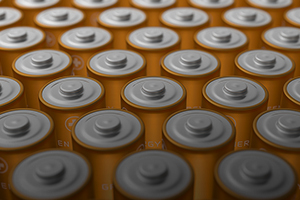Concrete Batteries

A new approach to a century-old design could someday make batteries out of buildings. The nickel-iron battery, patented by Thomas Edison in 1901, is a robust system that can be charged and recharged without compromising its performance, and can last for decades. This basic design is now being used to turn concrete into power storage cells, which can, in turn, be used to construct buildings.
Instead of an electrolyte solution, carbon fibers are mixed in with the cement. Layers of carbon fiber mesh coated with nickel or iron act as the cathode and anode. The batteries would be used to store energy generated from renewable sources like solar and wind. So far, the concept has proven to be capable of charging, discharging, and recharging; however, the batteries can only hold a small fraction of the power of a traditional battery.
In the current design, 200 square meters (over 2,000 square feet) of concrete would be needed to provide about 8 percent of the electricity used in a typical home. But cement-based concrete is the most widely used solid material in the world, and a single material that can provide both shelter and power could be a game-changer.
For information: Emma Zhang, Chalmers University of Technology, SE-412 96, Gothenberg, Sweden; phone: +46-(0)31-772-1100; email: emma.zhang@chalmers.se; Web site: https://www.chalmers.se/en/Pages/default.aspx or https://www.chalmers.se/en/projects/Pages/Rechargeable-cement-based-concrete-batteries.aspx